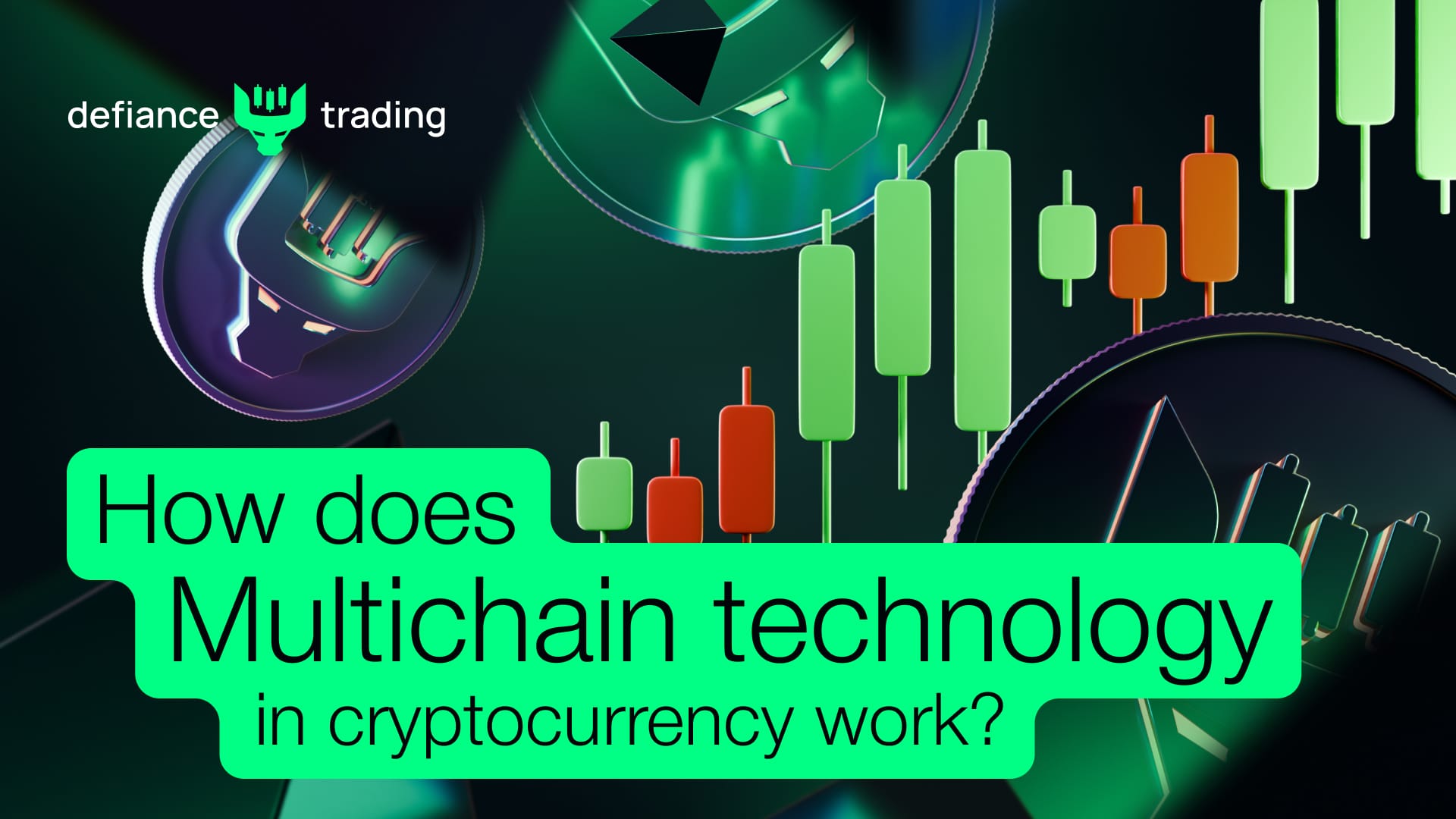How does multichain technology in cryptocurrency work?

The world of cryptocurrencies did not become beautiful overnight. It has faced its fair share of challenges, and in one such period, the idea of creating multichain technology in cryptocurrency emerged. This concept has changed how we view network stability, user experience, and gas fees.
Do you wonder why gas fees on native Ethereum are cut-throat, but using L2 is more pocket-friendly? Ethereum was the prototype for DApps, and every network founded since has taken lessons to build better. With multichain technology in cryptocurrency, blockchain users can interact with different networks and evade the issues related to isolated networks.
In this article, we will explore the place of multichain technology in cryptocurrency. We will see the origin of the concept, its advantages, how it works, and current applications.
Let’s dive in!
What is multichain technology in cryptocurrency?
Multichain technology in cryptocurrency is a blockchain technology involving many independent blockchains that can interact on a single network.
Within the network, each chain has peculiar rules related to consensus mechanisms and smart contracts. Also, the blockchain status can be private or public, depending on its purpose.
The paramount among the intentions for multichain is interoperability. This feature presents choices for asset transfer, DeFi, gaming, staking, and more. In the past, only single-network blockchains like Bitcoin and Ethereum existed. They constituted isolated islands without any safe landing except where you stand.
Multichain provides bridges between islands to allow you to enjoy the best of various worlds. This growing idea makes cryptocurrency and blockchain more exciting as cohesion exists.
The origin of multichain technology in cryptocurrency
The dream of multichain dates back to the recognition of Ethereum’s trilemma. Vitalik Buterin and Trent McConaghy coined the term trilemma after realizing that it is difficult to achieve the three desirable properties of a blockchain (decentralization, scalability, and security) at once. It concludes that just two can be achieved simultaneously with a compromise on the third. In Ethereum, scalability is left on the back burner.
Ethereum is the first blockchain with a platform for developers, and the initial traffic was massive. With a growing user base, Ethereum began to suffer transaction bottlenecks, which resulted in gas fee hikes. A solution like increasing transactions per block proved impossible because it would discourage miners. If the founders increased the block size without ecosystem consensus, decentralization would be lost.
Also, Ethereum is not custom-made for any specific purpose. As new applications emerged, Ethereum quivered under unexpected demands.
Initial approaches included side chains and Layer 2s, which led to established trilemma concerns. So what was left to do? Take the burden off a single chain. Build more chains that can work together.
Thus, multichain allows developers to scale on existing infrastructure without compromising decentralization and efficiency.
Advantages of multichain technology in cryptocurrency
Multichain has helped cryptocurrency in the following ways:
Interoperability
This means many chains can now work together. Multichain draws more users into the cryptocurrency ecosystem, where switching from one network to another to perform tasks is seamless. Networks can grow together with unprecedented value sharing.
Scalability
People build on blockchains every minute. This traffic can congest the network, slow transactions, and discourage users. Multichain shares network load and allows developers to stack on existing protocols undeterred.
Development
A multichain system breeds collaboration between partnering chains and brings about exciting innovation the ecosystem has never seen.
How does multichain technology in cryptocurrency work?
Whenever multichain is mentioned, interoperability comes to mind. It is one blockchain being compatible with another without dependence. This technology permits asset transfer, smart contract interaction, and data exchange between blockchains. Communication is possible through protocols called bridges.
These bridges usually lock assets on one chain and mint the equivalent on another chain, so you can perform transactions on your preferred ecosystem. If you want to change your assets back, the reverse occurs. The token equivalent is burned and your locked assets are released.
Another advantage is access. Take, for instance, Ethereum and Polygon. Polygon users can leverage its competitive gas fees and transaction speed on Ethereum DApps. This feature especially pays off for those transacting in low amounts and using the apps frequently.
Finally, bridging enhances liquidity across both networks and makes them fertile grounds for traders and investors.
Multichain can also operate through a sidechain. Here, secondary blockchains are subject to a main blockchain to help it function better and scale faster.
Then, there are atomic swaps. This swap allows you to trade cryptocurrencies across different networks without go-betweens.
Challenges of multichain technology in cryptocurrency and its difference with cross-chain
While the multichain design dispels scalability limits, it presents new challenges. The biggest one is fragmentation.
Fragmentation manifests in the following ways:
- Navigation difficulties
Multiple chains mean different wallets and dozens of private keys. Such overload can overwhelm users with little to no technical knowledge. Imagine having to withdraw to a centralized exchange before depositing on another network. This long process exposes sensitive details and takes time. - User division
Although channels to move to and from other networks opened, the independent network still appeared as silos. Without much incentive, users prefer to stay in a familiar environment than look elsewhere. - Shared liquidity
Low liquidity on a chain makes it vulnerable. Proof of Stake consensus showcases how this happens. Also, DEXs need lots of liquidity to remain highly efficient. If capital inflows are stretched thin, cracks will start to surface.
It is common for enthusiasts to mix up multichain with cross-chain. They are similar but different.
Multichain is the instant band-aid for the cryptocurrency space’s needs. More chains working together are resistant to increasing user activity.
On the other hand, the cross-chain concept answers the inadequacies of multichain and allows users to enjoy the goodness of various networks in one place.
Applications of multichain technology in cryptocurrency
On the decentralized web, these sectors have successfully integrated multichain technology;
- DeFi: in a multichain system, users can take advantage of yield and staking opportunities across networks to maximize profits.
- Supply chains: lost and damaged goods are things of the past. Multichain helps both companies and consumers track products in real time to ensure location and condition. The payment side of the transaction can follow immediately on another blockchain.
- Gaming: multichain provides gamers with immersive gaming experiences, fashioned by a horde of creative minds. It enables them to sell their digital assets with ease through different channels. To top it off, multichain opens up various revenue streams from playing many games.
Conclusion
Multichain remains a top stop in the blockchain train, and it will do wonders for Web3 in the years to come. When the Ethereum trilemma arose, the world assumed crypto was done. A further breakdown in network activity emboldened this conclusion until someone devised the idea of linking blockchains to share the traffic burden.
The solution started with sidechains, where other blockchains relieve one blockchain even though they revert to it. Ever since, cryptocurrency enthusiasts have kept striving for interoperability without hitches – one that doesn’t sacrifice the tripod upon which a blockchain should stand.
Today, multichain assists supply chain companies in delivering quality services and managing money, diversifying decentralized finance across many networks, and growing the gaming ecosystem into a career-worthy sector. This is the beginning of greater happenings for cryptocurrency.
For more information, kindly visit our WEBSITE today!
Ready to Defy the Odds?
Become part of a growing movement
